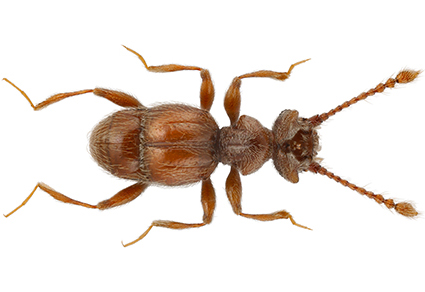Abstract
Trisinus tangliangi Ding, Ming & Yin, sp. nov. is described from Shenzhen, South China, which represents a third member of the T. cavernosus Ding, Niu & Yin species group. The new species shares the characteristic male cephalic excavation and aedeagal structures typical of the group, and can be readily distinguished from both congeners by the significantly more laterally dilated head and pronotum.
References
- Chandler, D.S. (2001) Biology, morphology and systematics of the ant-like litter beetles of Australia (Coleoptera: Staphylinidae: Pselaphinae). Memoirs on Entomology, International, 15, viii + 1–560.
- Braendle, C., Davis, G.K., Brisson, J.A. & Stern, D.L. (2006) Wing dimorphism in aphids. Heredity, 97 (3), 192–199. https://doi.org/10.1038/sj.hdy.6800863
- Ding, M.-L., Niu, X.-L. & Yin, Z.-W. (2025) A new species group of Trisinus Raffray (Coleoptera: Staphylinidae: Pselaphinae), with description of two new species from the Tianmu Mountains, China. Zootaxa, 5590 (2), 256–262. https://doi.org/10.11646/zootaxa.5590.2.5
- Kotyk, M. & a Varadínová, Z. (2017) Wing reduction influences male mating success but not female fitness in cockroaches. Scientific Reports, 7, 2367. https://doi.org/10.1038/s41598-017-02647-7
- Roff, D.A. & Fairbairn, D.J. (1993) The evolution of alternate morphologies: fitness and wing morphology in male sand crickets. Evolution, 47 (5), 1572–158. https://doi.org/10.1111/j.1558-5646.1993.tb02176.x
- Yin, Z.-W. (2022) The Batrisini of Tibet: unveiling an enigmatic ant-loving beetle diversity on Earth’s Third Pole (Coleoptera, Staphylinidae, Pselaphinae). Zootaxa, 5111 (1), 1–211. https://doi.org/10.11646/zootaxa.5111.1.1
- Zhang, C.-X., Brisson, J.A. & Xu, H.-J. (2019) Molecular mechanisms of wing polymorphism in insects. Annual Review of Entomology, 64 (1), 297–314. https://doi.org/10.1146/annurev-ento-011118-112448
- Ziabari, O.S., Zhong, Q., Purandare, S.R., Reiter, J., Zera, A.J. & Brisson, J.A. (2022) Pea aphid winged and wingless males exhibit reproductive, gene expression, and lipid metabolism differences. Current Research in Insect Science, 2, 100039. https://doi.org/10.1016/j.cris.2022.100039


